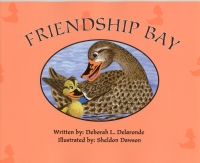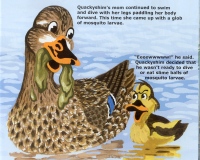| ________________
CM . . .
. Volume XI Number 6 . . . .November 12, 2004
excerpt:
In her first four picture books, A Name for a Metis, Little Metis & the Metis Sash, Flour Sack Flora and Flour Sack Friends, Deborah Delaronde of Duck Bay, MB, introduced young readers of all races to aspects of traditional Metis culture through the stories of two children, Little Metis and Flora. With Friendship Bay, Delaronde writes for a younger audience. In her dedication to Little Metis & the Metis Sash, she actually foreshadowed the theme of Friendship Bay when she wrote: "Despite the differences in our ages, families or cultural backgrounds, each of us has something unique that we can share with our family, friends and community." Instead of using the realistic style involving human characters that she had utilized in her earlier Metis books, with Friendship Bay Delaronde switches to an animal fantasy, one that uses water birds, in order to tell her story. Early in the spring, a mother duck arrives at a safe nesting place where she lays six eggs, but only one hatches. Because no other birds have yet arrived, the hatchling, Quackyshim, wonders, "Who will be my friend?" His mother assures him that other flocks will appear, but, in the meantime, she teaches him how to swim and find food plus how to duck and hide from danger. Quackyshim looks forward to other chicks hatching because then, being older, he'll be able to teach them what his mother has taught him. No others of his species appear, but three grebes do hatch nearby, and Quackyshim offers to instruct them in what he has learned, even though their mother wonders, "What can a duck teach a grebe?" While both Quackyshim and the grebe chicks share the ability to swim, when the grebe's mother begins to teach her young how to take off from the water by running on its surface, Quackyshim discovers that is something he cannot do. He is also unable to swim under the water like the grebes, and so he asks his mother, "How can we ever be friends when we're so different?" Mother duck finds an opportunity when all four youngsters are together and preening to ask, "Can you see one thing that we all do the same?" From the birds' shared act of preening, Quackyshim's mother leads her son to see other commonalities so that Quackyshim eventually concludes that, "although his new friends were different in many ways, they were the same too."
The message of Friendship Bay is one well worth sharing with preschool-grade 2 children who, like many adults, often focus too much on what separates us from others rather than seeing what we all have in common. An added bonus to the book is the natural science lesson about mallards that Delaronde has subtly imbedded within the story. While well worth purchasing for home or school, Friendship Bay could have been improved in terms of its design. On three pages, the black print has been overlaid on Dawson's illustration in such a way that the text is difficult to read. Recommended. Dave Jenkinson teaches courses in children's literature at the Faculty of Education, the University of Manitoba.
To comment
on this title or this review, send mail to cm@umanitoba.ca.
Copyright © the Manitoba Library Association. Reproduction for personal
use is permitted only if this copyright notice is maintained. Any
other reproduction is prohibited without permission.
NEXT REVIEW |
TABLE OF CONTENTS FOR THIS ISSUE
- November 11, 2004.
AUTHORS |
TITLES |
MEDIA REVIEWS |
PROFILES |
BACK ISSUES |
SEARCH |
CMARCHIVE |
HOME |

 Though Delaronde's text never mentions the ducks' breed by name, the illustrator, Sheldon Dawson, has elected to use a mallard, a very wise choice because it is North America's most common duck and one that has been or will likely be seen by most children. As well, the mallard is also one of the first species of ducks to arrive in the spring, and the male does not participate in the raising of the ducklings. Likely Delaronde also had mallards in mind since the foods she mentions in the text match the mallards' actual diet. Dawson's oil paintings, mostly full-page, blend a realistic setting with a somewhat cartoonish portrayal of the ducks. This mixture of styles works well though as it allows Dawson to portray the characters' emotions, especially those of Quackyshim. Like all good illustrators, Dawson goes beyond what the author's words say, and he adds further layers to the story via the details in his paintings. For example, when a very young Quackyshim ventures out on his own in the earlier portions of the book, Dawson places his mother in the background where she can unobtrusively watch over him. At one point, however, Dawson's accuracy of illustration could cause some difficulties for younger readers who may not be able to follow Quackyshim's quick transformation over three pairs of pages as he goes from being a yellow duckling to becoming an immature male (whose plumage resembles that of the female mallard) before assuming the familiar green-necked, white-ringed plumage of the adult.
Though Delaronde's text never mentions the ducks' breed by name, the illustrator, Sheldon Dawson, has elected to use a mallard, a very wise choice because it is North America's most common duck and one that has been or will likely be seen by most children. As well, the mallard is also one of the first species of ducks to arrive in the spring, and the male does not participate in the raising of the ducklings. Likely Delaronde also had mallards in mind since the foods she mentions in the text match the mallards' actual diet. Dawson's oil paintings, mostly full-page, blend a realistic setting with a somewhat cartoonish portrayal of the ducks. This mixture of styles works well though as it allows Dawson to portray the characters' emotions, especially those of Quackyshim. Like all good illustrators, Dawson goes beyond what the author's words say, and he adds further layers to the story via the details in his paintings. For example, when a very young Quackyshim ventures out on his own in the earlier portions of the book, Dawson places his mother in the background where she can unobtrusively watch over him. At one point, however, Dawson's accuracy of illustration could cause some difficulties for younger readers who may not be able to follow Quackyshim's quick transformation over three pairs of pages as he goes from being a yellow duckling to becoming an immature male (whose plumage resembles that of the female mallard) before assuming the familiar green-necked, white-ringed plumage of the adult.